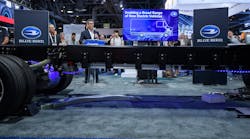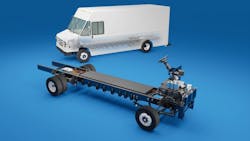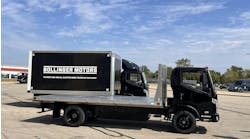LONG BEACH, California—After successfully rolling out hundreds of electric and low-emission school buses, Blue Bird is expanding into the commercial vehicle space with a new medium-duty EV chassis aimed at last-mile delivery.
The nearly 100-year-old OEM unveiled the Classes 5-6 chassis during the Advanced Clean Transportation (ACT) Expo. Thousands of fleet executives gathered here this week to explore the next wave of trucking technologies. It developed the prototype with Colorado-based Lightning eMotors.
Matthew Stevenson, who took over as Blue Bird's president and CEO last November, told FleetOwner that customer demand for an OEM-engineered EV solution is rising. With available capacity because of the more predictive school bus ordering trends, Stevenson saw an opportunity for Blue Bird to enter the emerging commercial EV market.
See also: Truck OEM execs talk EV charging infrastructure pain points
“Fleets said they want an OEM-engineered solution that they can get in one place, get warranty support, parts support, tech support, and a full aftermarket suite,” he said after unveiling the new chassis on the ACT Expo floor. “We have more than double the chassis capacity of what we actually need. And there are a lot of folks in this hall who do retrofits.”
Blue Bird's flexible Class 5-6 chassis, Stevenson explained, will enable a broad range of fully electric vehicles, including last-mile delivery step vans, motorhomes, and other specialty vehicles. The Blue Bird EV modular design allows for battery configurations ranging from 70kWh to 225kWh, which can support up to a 175-mile range on a charge. The battery packs take one to 12 hours to fully recharge, depending on the charging infrastructure.
The OEM will offer the EV chassis in three wheelbase options: 178 in., 190 in., and 208 in. for vehicles with a gross vehicle weight rating (GVWR) of up to 26,000 lbs. Stevenson noted that the equipment’s lightweight materials and components offer fleets more payload.
“We’ve put more EVs on the road than most of the truck manufacturers,” Stevenson said. “We have about 500 on the road today. We have a huge backlog on EVs. We started getting mainstream in EVs over three years ago.”
Low-emission transportation solutions aren’t new to Blue Bird. The OEM has about 20,000 propane, natural gas, and EV buses on roads today. School buses have been the “perfect EV application,” he noted. Those buses average 70 miles per day, returning to base twice daily
See also: More fleets are adding clean vehicles
The new CV chassis will offer Blue Bird safety features integrated into its EV school buses. These include “hill hold,” which prevents the vehicle from rolling backward when sitting stationary on a hill, and “electric creep,” which allows the vehicle to slowly start moving from a stop when the driver's foot is removed from the brake pedal to simulate a gasoline engine in gear. In addition, the Blue Bird custom chassis offers a tight turning radius ideal for maneuverability in tight urban settings.
Blue Bird’s longtime focus has been on Classes 5-7. While Stevenson expects step vans to be a popular configuration for his new chassis, the OEM is still deciding which customers would get the first models. “It’s a different business model—it’s more direct-to-fleet,” he explained. “We’re working with body builders like Morgan and Utilimaster, so it’s a different go-to-market. So all that is still coming together.”
Blue Bird teamed up with Lightning eMotors, a manufacturer of electric powertrains and zero-emission vehicle solutions, to build the Classes 5-6 custom chassis prototype. Lightning eMotors has 250 zero-emission electric commercial vehicles in operation with more than 1.5 million miles driven.
"We are ecstatic that Blue Bird chose us to be their powertrain partner for their debut into the commercial chassis market,” said Tim Reeser, CEO of Lightning eMotors. “Blue Bird's reputation for quality and safety is well-deserved, and we believe they will disrupt the market. We are also excited about the innovation they are bringing to the school bus market and look forward to deepening our partnership going forward."
The medium-duty EV space is crowded with startups. But Stevenson said he expects his OEM’s 95-year history gives it an advantage. “In terms of who the first customers are, we’re in a lot of discussions about that,” he said. “In this space, a lot of people that aren’t real OEMs have talked about things. But the fleets are saying, ‘Show me one first and then we’ll advance discussions.”





